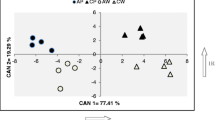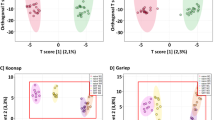Abstract
Phytophthora infestans is the most important potato pathogen worldwide. Various alternatives have been used to control the pathogen, including continuous applications of phenylamide fungicides which has caused a rapid development of resistance in populations of P. infestans. Despite the importance of the disease, metabolite profiling of fungicide-resistant P. infestans has not been reported. In vitro resistance of Phytophthora infestans isolates to metalaxyl was characterized and metabolic changes in resistant isolates were evaluated at low (0.5 mg/L) and high (100 mg/L) concentrations of the fungicide. About 70% of the isolates tested showed resistance to metalaxyl and a total of 49 metabolites were differently expressed in resistant isolates growing in the presence of the fungicide. Principal components analysis revealed a distinct metabolite profile of resistant isolates exposed to both low and high levels of metalaxyl. The main metabolites responsible for the clustering in both fungicide concentrations included fatty acids such as hexadecanoic and octadecanoic acids, sugars such as glucose and fructose, aminoacids such as proline and valine, and organic acids such as butanedioic and propanoic acids. Potential resistance-related metabolic pathways are mostly involved in the regulation of the pathogen’s membrane fluidity and included the fatty acid biosynthesis as well as the glycerophospholipid metabolism pathways. This is the first metabolomic-based characterization of fungicide resistance in plant pathogens.




Similar content being viewed by others
References
Aav, A., Skrabule, I., Bimšteine, G., Kaart, T., Williams, I. H., & Runno-Paurson, E. (2015). The structure of mating type, metalaxyl resistance and virulence of Phytophthora infestans isolates collected from Latvia. Zemdirbyste-Agriculture, 102(3), 335–342.
Aliferis, K. A., & Chrysayi-Tokousbalides, M. (2011). Metabolomics in pesticide research and development: Review and future perspectives. Metabolomics, 7(1), 35–53.
Cenis, J. L. (1992). Rapid extraction of fungal DNA for PCR amplification. Nucleic Acids Research, 20(9), 2380 http://www.ncbi.nlm.nih.gov/pubmed/1594460. Accessed 26 November 2016.
Cevallos-Cevallos, J., & Reyes-De-Corcuera, J. I. (2012). Metabolomics in food science. Advances in Food and Nutrition Research, 67, 1–24.
Cevallos-Cevallos, J., Rouseff, R., & Reyes-De-Corcuera, J. I. (2009). Untargeted metabolite analysis of healthy and huanglongbing-infected orange leaves by CE-DAD. Electrophoresis, 30(7), 1240–1247.
Cevallos-Cevallos, J., García-Torres, R., Etxeberria, E., & Reyes-De-Corcuera, J. I. (2011a). GC-MS analysis of headspace and liquid extracts for metabolomic differentiation of citrus huanglongbing and zinc deficiency in leaves of “Valencia” sweet orange from commercial groves. Phytochemical analysis : PCA, 22(3), 236–246.
Cevallos-Cevallos, J., Danyluk, M. D., & Reyes-De-Corcuera, J. I. (2011b). GC-MS based metabolomics for rapid simultaneous detection of Escherichia coli O157:H7, Salmonella Typhimurium, Salmonella Muenchen, and Salmonella Hartford in ground beef and chicken. Journal of Food Science, 76(4), M238–M246.
Cevallos-Cevallos, J. M., Futch, D. B., Reyes-De-Corcuera, J. I., Folimonova, S. Y., & Shilts, T. (2012). GC–MS metabolomic differentiation of selected citrus varieties with different sensitivity to citrus huanglongbing. Plant Physiology and Biochemistry, 53, 69–76.
Childers, R., Danies, G., Myers, K., Fei, Z., Small, I. M., & Fry, W. E. (2015). Acquired resistance to mefenoxam in sensitive isolates of Phytophthora infestans. Phytopathology, 105(3), 342–349.
Davidse, L. C., Gerritsma, O. C. M., Ideler, J., Pie, K., & Velthuis, G. C. M. (1988). Antifungal modes of action of metalaxyl, cyprofuram, benalaxyl and oxadixyl in phenylamide-sensitive and phenylamide-resistant strains of Phytophthora megasperma F. Sp. medicaginis and Phytophthora infestans. Crop Protection, 7(6), 347–355.
Dawaliby, R., Trubbia, C., Delporte, C., Noyon, C., Ruysschaert, J.-M., Van Antwerpen, P., & Govaerts, C. (2016). Phosphatidylethanolamine is a key regulator of membrane fluidity in eukaryotic cells. The Journal of Biological Chemistry, 291(7), 3658–3667.
Fiehn, O. (2001). Combining genomics, metabolome analysis, and biochemical modelling to understand metabolic networks. Comparative and Functional Genomics. doi:10.1002/cfg.82.
Goodwin, S., Sujkowski, L., & Fry, W. (1996). Widespread distribution and probable origin of resistance of metalaxyl in clonal genotypes of Phytophthora infestans in the United States and western Canada. Ecology and Epidemiology, 86(7), 793–800.
Grünwald, N. J., Sturbaum, A. K., Montes, G. R., Serrano, E. G., Lozoya-Saldaña, H., & Fry, W. E. (2006). Selection for fungicide resistance within a growing season in field populations of Phytophthora infestans at the Center of Origin. Phytopathology, 96(12), 1397–1403.
Kanehisa, M., & Goto, S. (2000). KEGG: Kyoto encyclopedia of genes and genomes. Nucleic Acids Research, 28(1), 27–30 http://www.ncbi.nlm.nih.gov/pubmed/10592173. Accessed 28 November 2016.
Ma, Z., & Michailides, T. J. (2005). Advances in understanding molecular mechanisms of fungicide resistance and molecular detection of resistant genotypes in phytopathogenic fungi. Crop Protection, 24(10), 853–863.
Maridueña-Zavala, M. G., Villavicencio-Vásquez, M. E., Cevallos-Cevallos, J. M., & Peralta, E. L. (2016). Molecular and morphological characterization of Moniliophthora roreri isolates from cacao in Ecuador. Canadian Journal of Plant Pathology, 38(4), 460–469.
Matson, M. E. H., Small, I. M., Fry, W. E., & Judelson, H. S. (2015). Metalaxyl resistance in Phytophthora infestans : Assessing role of RPA190 Gene and Diversity within clonal lineages. Phytopathology, 105(12), 1594–1600.
Mukalazi, J., Adipala, E., Sengooba, T., Hakiza, J. J., Olanya, M., & Kidanemariam, H. M. (2001). Metalaxyl resistance, mating type and pathogenicity of Phytophthora infestans in Uganda. Crop Protection, 20(5), 379–388.
Palma-Guerrero, J., Lopez-Jimenez, J. A., Pérez-Berná, A. J., Huang, I.-C., Jansson, H.-B., Salinas, J., et al. (2010). Membrane fluidity determines sensitivity of filamentous fungi to chitosan. Molecular Microbiology, 75(4), 1021–1032.
Pérez, W., Lara, J., & Forbes, G. A. (2009). Resistance to metalaxyl-M and cymoxanil in a dominant clonal lineage of Phytophthora infestans in Huánuco, Peru, an area of continuous potato production. European Journal of Plant Pathology, 125(1), 87–95.
Pluskal, T., Castillo, S., Villar-Briones, A., & Orešič, M. (2010). MZmine 2: Modular framework for processing, visualizing, and analyzing mass spectrometry-based molecular profile data. BMC Bioinformatics, 11(1), 395.
Randall, E., Young, V., Sierotzki, H., Scalliet, G., Birch, P. R. J., Cooke, D. E. L., et al. (2014). Sequence diversity in the large subunit of RNA polymerase I contributes to mefenoxam insensitivity in Phytophthora infestans. Molecular Plant Pathology, 15(7), 664–676.
Riveros, F., Sotomayor, R., Rivera, V., Secor, G., & Espinoza, B. (2003). Resistance of Phytophthora infestans (Montagne) de Bary to metalaxyl in potato crops in northern Chile 1. Agricultura tecnica de Chile, 63(2), 117–124.
Robson, G. D., Wiebe, M., Kuhn, P. J., & Trinci, A. P. J. (1990). Inhibitors of phospholipid biosynthesis. In P. J. Kuhn, A. P. J. Trinci, M. J. Jung, M. W. Goosey, & L. G. Copping (Eds.), Biochemistry of Cell Walls and Membranes in Fungi - Google Libros (1st ed., pp. 261–279). New York.
Tamura, K., Stecher, G., Peterson, D., Filipski, A., & Kumar, S. (2013). MEGA6: Molecular evolutionary genetics analysis version 6.0. Mol. Biol. Evol, 30, 2725–2729.
Turk, M., Meanelle, L., Marjeta, A., Entjurc, Š., Grimalt, J. O., Gunde-Cimerman, N., & Plemenitasšalt, A. (2004). Induced changes in lipid composition and membrane fluidity of halophilic yeast - like melanized fungi. Extremophiles, 8, 53–61.
Wang, X., Guo, M., Min, F., Gao, Y., Xu, F., Yang, S., & Lu, D. (2012). Virulence complexity and high levels of fungicide resistance suggest population change of Phytophthora infestans in the Heilongjiang Province of China. Potato Research, 55(3–4), 217–224.
Warth, B., Parich, A., Bueschl, C., Schoefbeck, D., Neumann, N. K. N., Kluger, B., et al. (2015a). GC–MS based targeted metabolic profiling identifies changes in the wheat metabolome following deoxynivalenol treatment. Metabolomics, 11(3), 722–738.
Warth, B., Parich, A., Bueschl, C., Schoefbeck, D., Neumann, N. K. N., Kluger, B., et al. (2015b). GC–MS based targeted metabolic profiling identifies changes in the wheat metabolome following deoxynivalenol treatment. Metabolomics, 11(3), 722–738.
Yogendra, K. N., Kushalappa, A. C., Sarmiento, F., Rodriguez, E., Mosquera, T., Bassard, J., et al. (2014). Metabolomics deciphers quantitative resistance mechanisms in diploid potato clones against late blight. Functional Plant Biology, 42(3), 284–298.
Yogendra, K. N., Kushalappa, A. C., Sarmiento, F., Rodriguez, E., & Mosquera, T. (2015). Metabolomics deciphers quantitative resistance mechanisms in diploid potato clones against late blight. Functional Plant Biology, 42(3), 284–298.
Acknowledgements
This research was financially supported by Escuela Superior Politécnica del Litoral (CIBE-ESPOL) and VLIR NETWORK Ecuador. Authors thank Jose Ochoa from the National Institute of Agricultural Research for donating the P. infestans isolates for this research.
Author information
Authors and Affiliations
Corresponding author
Rights and permissions
About this article
Cite this article
Maridueña-Zavala, M.G., Freire-Peñaherrera, A., Cevallos-Cevallos, J.M. et al. GC-MS metabolite profiling of Phytophthora infestans resistant to metalaxyl. Eur J Plant Pathol 149, 563–574 (2017). https://doi.org/10.1007/s10658-017-1204-y
Accepted:
Published:
Issue Date:
DOI: https://doi.org/10.1007/s10658-017-1204-y




